Over the last eight weeks we have learned a lot about the magic molecule we call water.
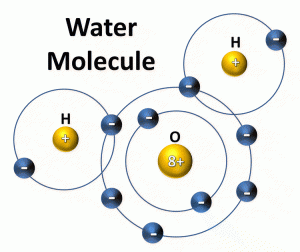
Image: Florida Atlantic University
In Lesson 1 we learned that it is a polar – that it is like a magnet and thus, attaches to itself and separates many other compounds. Though we did not discuss it, it is also why it takes longer to heat and cool water.
In Lesson 2 we discussed the water cycle – how water evaporates into the atmosphere, condenses into clouds, rains back to Earth, flows to the sea, and starts the cycle all over again.
In Lesson 3 we looked at how the water forms our landscape. It rains in the mountains and flows back to the sea, forming streams, creeks, rivers, canyons, plains, bays, and more. It is the reason we have hills in parts of our town where they are, and why other parts are swamps. All of this generates different kinds of plants and animals.
In Lesson 4 we discussed how the polar water molecule dissolves rocks and minerals as it flows towards the sea, increasing the amount of elements as it does and increasing the saltiness, we call salinity. This too creates new plants and animals and we discussed why some creatures can live in seawater and others cannot.
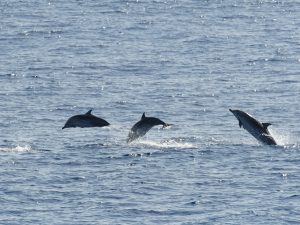
Photo: NOAA
In Lesson 5 we talked about how important water is to life. How plants and animals MUST have it and spend a significant amount of time looking for it. We also talked about how important it is to you and that you should drink plenty of water each day.
In Lesson 6 we talked about compounds that do not dissolve in water – like fats and oils. These compounds make up the “skin” of our cells and our bodies so that we do not dissolve with water inside of us, and for some creatures, outside of us.
Last week we looked at water quality. Over time we added compounds to our water systems that have made our water unlivable for some creatures, and undrinkable for us. Much has been done in the last 40 years to try and clean this up, and there is more we can do.
So, that brings us to the eighth and last lesson in this series. We will wrap up by discussing water quantity.
We will begin by stating that all the water that has been on this planet is still here. It evaporates, condenses, precipitates, and starts again – we have not lost any. So, the quantity is the same – where you can find is a different deal.
In the 1800s John Wesley Powell was hired by the U.S. government to explore new land holdings. In his report he mentioned that the western United States was going to be difficult to settle because of the lack of water – but that Florida would NEVER need to worry about it – there was water everywhere.
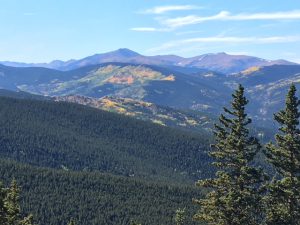
Each July, my wife and I load up our truck and go camping out west. We found what Lt. Colonel Powell found – it is dry out there. No campsite we went to did you have a water faucet at your site. There was either one at the entrance of the campground, or you had to get it a grocery store or gas station in town. We would stop, fill our 5-gallon cooler, and that would be all the water we would have for the next 2-3 days. All the water for cooking, brushing our teeth, washing our hair, and drinking. We learned VERY quickly how to conserve water. How to use the same pot of water for several different needs. It was VERY strange to come home to Florida, unload the truck, and POUR THE WATER OUT OF THE COOLER INTO THE STREET before storing it for the next camping trip. Both my wife and I froze when we thought about doing it. Just a day ago we would NEVER have just poured that water out into the street – NO WAY!
But here in Florida, we never think twice about it. We water our lawns like there is no tomorrow and many times, while it is raining. When we turn the faucet on at home, water always comes out. We can shower five times a day if we want and each shower can be 30-minutes. Such a different world than Arizona. But was John Wesley Powell right? Does Florida never have to worry about water? Turns out, maybe we do.
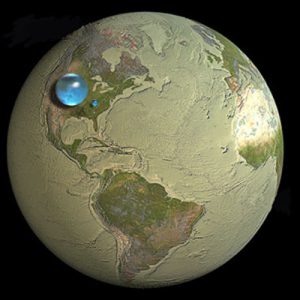
Image: USGS
Of all the water on the planet – 90% of this is saltwater – the oceans are huge – and we cannot drink saltwater. As we learned saltwater will cause freshwater in our cells to diffuse out. This will dehydrate us (read Lesson 4). The remaining 10% is freshwater and most of it is frozen as ice at the north and south poles. This leaves about 1-3% of the water on the planet as flowing freshwater for us to use (see graphic that I included in this post).
But where is this water?
Well… it is divided into surface water and ground water. Many communities get their water from surface water sources. My daughter out in Colorado gets her drinking from a reservoir they created. Many places out west do this. They channel surface water from rivers and streams into man-made lakes they call reservoirs, and this is it. They are not allowed to swim in their community reservoir (which they call a lake). They fish in it, paddle on it, and they do ice skate on it in winter, but no one can be “in it” because you are going to have to drink this.
The city of Los Angeles is in the same boat, but as you might expect – they have more than one “lake” to provide water for them. It is kind of scary to think that the water that you MUST have is in these small “lakes” and that it is needed for literally millions of people. Many communities out west have strict rules about washing your cars or bathing your dogs. Then you look at a place like Las Vegas… water fountains spraying everywhere – it does not make sense really.
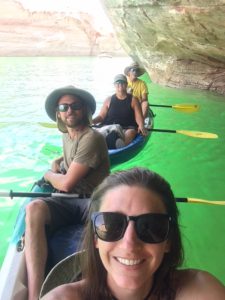
They have another problem out there. Because of the warm dry climate, it does not rain much (hence why they have water problems – and climate change is a whole nother story) but the weather is perfect for growing crops. California is a major agriculture state but to keep it going they need water. Water in an area where there is not much. So, a lot of the water in those “lakes”/reservoirs we were talking about – that people need for drinking, cooking, and bathing – must go to the farms for food.
You guessed it…
There are “water wars” going on out there.
But what about ground water?
Yep… it is there.
There are millions of gallons of water under the Earth in porous rock we call an aquifer and we have found it. They drill pipes down to it and pump it up. This can be used for drinking, bathing, farming. However, in recent years they have pumped the water out faster than the water cycle we learned about in Lesson 2 can put it back – and in some places, the wells are running dry.
Again, this is scary stuff… we NEED water.
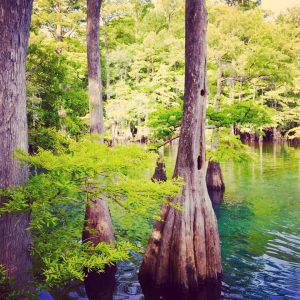
What about Florida?
Most of Florida gets their water from an aquifer. Some communities may have a reservoir or “lake”, but most get it from the ground. And yes… we draw it down faster than the water cycle can replace it.
Why?
What are we doing to draw SO much water out?
Everything… we drink it, bath with it, water our lawns, water our farms, use it in industrial processing, and just leave the faucet running sometimes. It appears John Wesley Powell may have been wrong. We may have to worry about it. So far, there have been no shortages. So far, we have not been told we cannot wash our cars or bath our dogs. But if we don’t pay attention to the fabulous resource, we are lucky to have so much of – this could happen.
There is no reason to wait until we are in trouble to begin conserving water as they do out west – actually, it would be pretty smart to do so. So, for our activity today – let’s see where our water goes and how we might conserve it now.
ACTIVITY
– Where does your water go? Make a list of what you use water for every day. Washing clothes, watering the lawn, drinking, cooking – make a list of everywhere you can think of that water has to be running for it to work – dishwasher, etc.
– Which ones on this list do you use A LOT. Those are obviously important if you use them a lot. So, you will need them – but can you use them less? Can you use them smarter? Can you think of where you might be wasting water when using them?
– Those that are not used a lot. Look at these. You are not using them a lot because you do not really need them? Maybe you are already being smarter on using them? Can you be even smarter?
– Is there anything on your list you can do without? When we were camping out west, we did find some things we could do without.
– We did find things that we could REUSE the water for. Water boiled in the morning for coffee could be used to wash dishes as well. Many Floridians are now using rain barrels to collect the rainwater and water their gardens instead of using sprinklers. I know someone who does a similar thing with their washing machine water. You can contact your local extension office for ideas on how to use water smarter.
– Here is a challenge… can you and your family reduce your water bill? Think of ways that you can and see if you can do it. We usually pay about $60/month for ours. It is a game for us to see if we can get it lower. Because of the drought we are in right now, we have run the sprinklers more than we usually do and our bill has been running around $80/month. But with no rain, things are tough. We have already begun discussing how we are going to change our landscaping if this becomes a “normal spring” so we do not have to run the sprinkler more. The climate seems to be changing – but that is a whole nother story.
Camping out west was a real eye opener for us, and we are trying hard to do better.
Sorry for such a long lesson today – but it is actually an important topic for youth and adults. We need to be thinking about where our water comes from and how we are using it. We need to be smarter. We NEED water – IT’S A MAGIC MOLECULE
HAVE FUN AND STAY SAFE
 0
0
